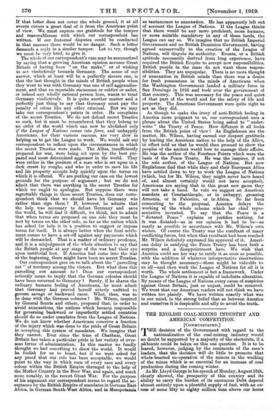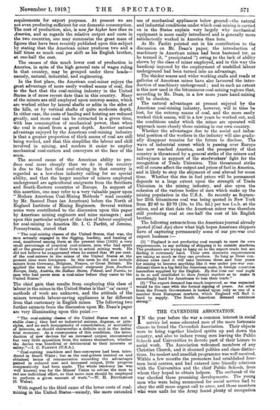THE ENGLISH COAL-MINING INDUSTRY AND AMERICAN COMPETITION.
[COMMUNICATED.]
THE decision of the Government with regard to the nationalization of the coal-mining industry would no doubt be supported by a majority of the electorate, if a plebiscite could be taken on this one question. It is to be feared, however, judging by the comments of the men's leaders, that the decision will do little to promote that whole-hearted co-operation of the miners in the working of the mines which is so essential for an increase of coal production during the coming winter. As. Mr. Lloyd George in his speech of Monday, August 18th, clearly showed, the prosperity of this country and its ability to carry the burden of its enormous Debt depend almost entirely upon a plentiful supply of fuel, with an excess of some fifty to eighty million tons above our home requirements for export purposes. At present we are not even producing sufficient for our domestic consumption. The cost of production, also, is now far higher here than in America, and as regards the relative output and costs in the two countries, one may summarize the great mass of figures that have been recently published upon this subject by stating that the American miner produces two and a half times as much coal per shift as his English brother, at one-half the cost.
The causes of this much lower cost of production in America, in spite of the high general rate of wages ruling in that country, may be grouped under three heads— namely, natural, industrial, and engineering.
In the first place, the American coal-miner enjoys the great advantage of more easily worked seams of coal, due to the fact that the coal-mining industry in the United States is of more recent date than in this country. Many of the miners are still employed upon outcrop seams, which are worked either by lateral shafts or edits in the sides of the hills, or by vertical shafts of quite moderate depth. In either case, the costs of hauling and hoisting are reduced greatly, and more coal can be extracted in a given time, with less consumption of mechanical power, than when -the coal is raised from a great depth. Another natural advantage enjoyed by the American coal-mining industry is that a greater proportion of thick seams of coal are still • being worked, and that this simplifies the labour and skill involved in mining, and renders it easier to employ mechanical coal-cutters and conveyors at -the face of the seam.
The second cause of the American ability to produce coal more cheaply than we do in this country is due to the fact that coal-mining in that country is regarded as a low-class industry calling for no special ability, and that the larger number of miners employed underground are agricultural emigrants from the Southern and South-Eastern countries of Europe. In support of this assertion, one may refer to a very valuable paper upon " Modern American Coal-Mining Methods " read recently by Mr. Samuel Dean (an American) before the North of England Institute of Mining Engineers. Several written notes were contributed to the discussion upon this paper by American mining engineers and mine managers ; and upon this particular subject of the class of labour employed for coal-mining in America Mr. I. C. Parfitt, of Jerome, Pennsylvania, stated that " The coal-mining classes of the United States, that was, the men actually engaged in the digging, loading, and hauling of coal, numbered among them at the present time [1916] a very small percentage of practical coal-miners, men who had spent all or the greater part of their lives in actual mining work. He did not believe he exaggerated when he stated that 90 per cent. of the coal-miners• in the mines of the United States at the present time were foreigners. In this term he did not include miners from Germany, Belgium, France, or Great Britain. He applied the term to the agricultural emigrants from Southern Europe, Italy, Austria, the Balkan States, Poland, and Russia, to men who had never seen a coal-mine before they came to the United States."
The chief gain that results from employing this class of labour in the mines in the United States is that" ea' canny " methods of work are unknown, and the attitude of the miners towards labour-saving appliances is far different from that customary in English mines. The following two further extracts from the discussion upon Mr. Dean's paper are very illuminating upon this point :— " The coal-mining classes of the United States were not a stable class ;] they had no industrial axioms, dogmas, or principles, and no such homogeneity of consolidation, of mutuality of interests, as should characterize a definite unit in the industrial economy. As a consequence of this condition, the intro. duction of new devices for an increased output encountered but very little opposition from the miners themselves, whether the device was beneficial or detrimental to their interests or safety."—I. C. PeurnT (U.S.A.).
" Coal-cutting machines and face-conveyors had been introduced in South Wales ; but as the coal-getters insisted on and obtained terms of remuneration exceeding the advantages gained in reduced cost and increased output, little progress comparatively had been made. The whole tendency (as was well known) was for the Miners' Union to advise the men to red uce individual effort, so that more men should be employed to perform a given amount of work."—W. H. ROUTLEDGE (S. Wales).
With regard to the third cause of the lower costs of coalmining in the United States—namely, the more extended use of mechanical appliances below ground—the natural and industrial conditions under which coal-mining is carried on in the States explain very largely why mechanical equipment is more easily introduced and is generally more satisfactorily worked in America than here. As Mr. Parfitt pointed out in his contribution to the discussion on Mr. Dean's paper, the introduction of machinery in American mines had been hastened (or, as he termed it, " precipitated ") owing to the lack of ability shown by the class of miner employed, and in this way the handicap imposed by the employment of unskilled labour underground had been turned into an advantage. The thicker seams and wider working stalls and roads or galleries of American mines have also favoured theintroduction of machinery underground ; and to such an extent is this now used in the bituminous coal-mining regions that, according to Mr. Dean, in a few more years hand-mining will be obsolete.
The natural advantages at present enjoyed by the American coal-mining industry, however, will in time be lost, for the outcrop seams of coal, and the more easily worked thick seams, will in a few years be worked out, and the conditions under which the mines are operated will approach more closely those existing in our own country. Whether the advantages due to the social and industrial position of the workers in the industry will also gradually disappear remains for the future to disclose. The wave of industrial unrest which is passing over Europe has now reached America, and the prosperity of that country is threatened by a general strike of the miners and railwaymen in support of the steelworkers' fight for the recognition of Trade Unionism. This threatened strike will of course affect the output and prices of fuel in America, and is likely to stop the shipment of coal abroad for some time. Whether this rise in fuel prices will be permanent depends to a large extent upon the strength of Trade Unionism in the mining industry, and also upon the cohesion of the various bodies• of men which make up the mining population in the U.S.A. So recently as September 25th bituminous coal was being quoted in New York from $2.40 to $3.70 (10s. to 15s. 6d.) per ton f.o.b. at the mines, and at that date the American miner was therefore still producing coal at one-half the cost of his English brother.
The following extracts from the Americanjournal already quoted (Coal Age) show what high hopes American shippers have of capturing permanently some of our pre-war coal export business :— (1) " England is not producing coal enough to meet its own requirements, to say nothing of shipping it to outside marketed The producers are trying to hang on to the export trade but are finding it extremely hard. Their own domestio requirements are taking as much ae they can produce. So long as these conditions exist (and it will take between three and four years for mining to become anything like it was under pre-war conditions) there is a big field for American coals, in foreign countries heretofore supplied by the English. By that time our coal ought to be so well established in these foreign markets as to make it exceedingly hard for Americans to lose their trade."
(2) "The export demand has much improved; as was expected would be the case with the formal signing of peace. An order from the French Government is looked' upon only as one of a number from European markets, which End will find it hard to supply. The South American demand continues strong."







































 Previous page
Previous page